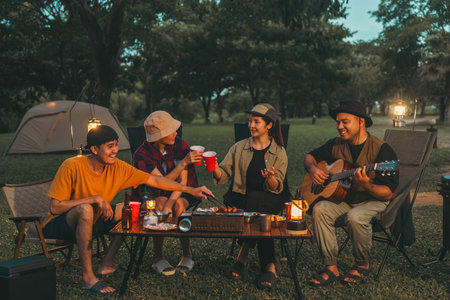Setting Goals for a Green Gathering
When organizing a group camping trip with an eco-friendly mindset, the first step is to define your group’s shared environmental intentions. Start by having an open conversation about why sustainability matters to your adventure and what “green” means for everyone involved. Are you committed to minimizing single-use plastics? Do you want to prioritize carpooling, or choose a campsite that supports local conservation efforts? Setting these goals early helps ensure everyone is on the same page.
Once your eco-friendly objectives are clear—like reducing waste, using reusable gear, and supporting sustainable brands—make sure to communicate them to all participants. Send out a group message or create a digital checklist outlining your priorities and expectations. Encourage everyone to share their own ideas for keeping your trip low-impact and fun. When every camper feels invested in the cause, it becomes much easier to make green choices together throughout the planning process and while out in nature.
Choosing an Eco-Conscious Campsite
When planning a group camping trip with sustainability in mind, where you stay matters just as much as what you do. The first step is to research and select campgrounds that actively support conservation efforts, provide comprehensive recycling options, and encourage campers to follow Leave No Trace principles. These features not only minimize your group’s environmental impact but also set the tone for a responsible outdoor experience.
Key Criteria for Selecting an Eco-Friendly Campsite
| Criteria | What to Look For | Why It Matters |
|---|---|---|
| Conservation Initiatives | Protected areas, native plant restoration, wildlife corridors | Supports local ecosystems and preserves natural beauty for future generations |
| Recycling Facilities | Clearly marked bins for paper, plastics, composting stations | Reduces landfill waste and encourages mindful consumption habits within your group |
| Leave No Trace Education | On-site signage, ranger-led talks, or informational brochures | Empowers campers to minimize their footprint through simple, actionable steps |
| Sustainable Infrastructure | Solar-powered showers, eco-friendly toilets, water refill stations | Lowers resource consumption while providing comfort and convenience |
| Group Accommodation Policies | Limits on group size, designated group sites to avoid overuse of sensitive areas | Helps protect local flora and fauna while ensuring everyone has space to enjoy nature responsibly |
Pro Tip: Connect with Campground Staff Before Booking
If you’re unsure about a campsite’s eco-credentials, reach out directly. Ask about their sustainability policies, how they handle waste management, and whether they partner with local conservation organizations. Their answers will help you choose a spot that aligns with your group’s green goals.

3. Planning Low-Impact Transportation
One of the most effective ways to keep your group camping trip eco-friendly is by thoughtfully planning your transportation. Start by coordinating carpooling among your group members—set up a shared ride schedule or use an app like GroupMe or Google Sheets to organize who’s driving and how many seats are available. Carpooling not only reduces the number of vehicles on the road, but it also makes the journey more fun and collaborative.
Another sustainable option is to consider public transit where possible. Many state and national parks in the U.S. are accessible by bus or train, especially those near major cities. Doing a bit of research on local transit routes can be both budget-friendly and a great way to cut down on emissions. If you’re feeling adventurous, renting bikes or using park shuttle services can add a unique touch to your travel experience while keeping things green.
If neither carpooling nor public transit is viable for your crew, try selecting campground locations closer to home. Choosing a site within an hour or two of your city not only minimizes gas usage but also allows for spontaneous weekend getaways without the hassle of long drives. Remember, the less time you spend on the road, the more time you have to enjoy nature—and with a lighter carbon footprint too!
4. Eco-Friendly Menu Planning
When it comes to planning meals for your group camping trip, making eco-friendly choices can be both delicious and impactful. Start by organizing group meals that utilize local and organic ingredients whenever possible. Shopping at nearby farmers markets not only supports the community but also reduces the carbon footprint associated with transporting food long distances.
Embrace Plant-Based Recipes
Choosing plant-based recipes is an excellent way to lessen your environmental impact while still enjoying flavorful, crowd-pleasing dishes. Plant-based meals require fewer resources to produce and generate less waste, making them a natural fit for sustainable camping trips. Consider hearty salads, grilled veggie skewers, lentil stews, or vegan chili as some go-to options.
Sample Eco-Friendly Group Menu
| Meal | Menu Idea | Main Ingredients |
|---|---|---|
| Breakfast | Overnight oats with seasonal fruits | Oats, almond milk, local berries, nuts |
| Lunch | Chickpea salad wraps | Chickpeas, whole wheat wraps, lettuce, tomatoes, cucumbers |
| Dinner | Grilled vegetable kebabs & quinoa salad | Zucchini, bell peppers, mushrooms, quinoa, lemon vinaigrette |
| Dessert | Baked apples with cinnamon | Local apples, cinnamon, maple syrup |
Prioritize Reusable Dishware and Minimize Waste
Avoid single-use plastics by bringing reusable plates, cups, and utensils for everyone in your group. Encourage campers to pack their own mess kits and water bottles. Set up a simple dishwashing station using biodegradable soap and mark a designated spot for composting food scraps. By being intentional with meal planning and clean-up routines, you’ll keep your group’s waste minimal and your campsite pristine.
5. Packing with a Purpose
One of the most impactful ways to ensure your group camping trip is eco-friendly is by paying careful attention to what you pack—and how you pack it. Start by compiling a group packing list that prioritizes reusable, multi-purpose, and sustainable gear. Instead of everyone bringing their own single-use items, think about sharing essentials like cookware, water filters, and lanterns. Look for equipment made from recycled or responsibly sourced materials, and opt for biodegradable toiletries and cleaning supplies whenever possible.
Encourage your group to borrow or rent gear rather than buying new items just for this trip. Local outdoor retailers and online platforms often offer rental services for tents, sleeping bags, and other bulky equipment. Not only does this save money and reduce waste, but it also lightens everyone’s load—literally and figuratively. For those must-have items you can’t find secondhand, choose quality pieces designed to last through many future adventures.
Don’t forget the small details that add up: reusable water bottles, food containers, utensils, and cloth napkins help keep single-use plastics out of nature. When prepping group meals, coordinate who brings what to minimize excess packaging and avoid food waste. By making thoughtful choices together, your group sets a positive example—and proves that sustainability can be woven into every step of the adventure.
6. Nature-Friendly Activities and Education
One of the most rewarding aspects of an eco-friendly group camping trip is the opportunity to connect with nature in mindful and meaningful ways. To foster a deeper appreciation for the outdoors, consider organizing activities that celebrate and respect your natural surroundings. For example, you can arrange guided hikes led by local experts who can share insights about native plants, wildlife, and the unique ecosystems around your campsite. These walks not only promote physical activity but also encourage campers to observe the environment with curiosity and care.
Wildlife observation sessions are another engaging way to immerse your group in the beauty of the outdoors while practicing responsible behavior. Equip everyone with binoculars or field guides, and remind them to keep a respectful distance from animals and avoid disrupting their habitats. Birdwatching or early morning animal tracking can turn into memorable experiences that highlight the importance of biodiversity.
Group Discussions on Environmental Stewardship
Taking time for group discussions around the campfire can be both educational and inspiring. Use these moments to talk about environmental stewardship—what it means, why it matters, and how each camper can make a difference. You might explore topics like Leave No Trace principles, sustainable camping gear choices, or recent conservation efforts in your region. Encourage everyone to share their own eco-friendly habits or brainstorm new ways to reduce your group’s impact on future trips.
Hands-On Learning Opportunities
If your group is interested, you could also include hands-on learning opportunities such as a mini-workshop on composting food scraps, identifying invasive species, or even participating in a small-scale trail cleanup project together. Activities like these not only benefit the environment but also leave campers with practical skills they can use beyond this trip.
Cultivating Lasting Eco-Conscious Habits
Ultimately, integrating nature-friendly activities and open conversations about sustainability helps foster a culture of respect and responsibility within your group. By making education a fun and integral part of your camping adventure, you’re empowering everyone to become better stewards of the planet—both during this trip and long after you pack up your tents.
7. Waste Management and Clean-Up
One of the most crucial elements of eco-friendly camping is ensuring your group leaves no trace—ideally, leaving your site even cleaner than you found it. Establishing clear waste management protocols before your trip makes a world of difference. Start by assigning specific roles within your group: who will bring reusable trash bags, who’s in charge of compostable scraps, and who will monitor recycling? Make sure everyone knows which items can be recycled, composted, or must be packed out as landfill waste.
Set Up a Sorting Station
When you arrive at your campsite, designate a central spot for waste sorting with clearly labeled bins or bags for recyclables, compost, and trash. Use sturdy containers that won’t blow away in the wind and are animal-resistant. Encourage campers to rinse recyclables if water is available, and remind everyone that food scraps should only go into compost bins—not left behind or buried.
Plan for Pack-In, Pack-Out
Many American campgrounds follow a strict “pack-in, pack-out” policy—meaning everything you bring must leave with you. Before heading home, double-check the entire campsite for micro-trash like food wrappers, bottle caps, or twist ties. Bring along gloves for everyone during the final sweep and make it a fun group activity rather than a chore.
Leave It Better Than You Found It
As an eco-minded group, take your stewardship a step further by picking up litter left by previous visitors if you find any. This small act not only improves the environment but also sets a positive example for other campers. Share your clean-up efforts on social media to spread awareness—just remember to tag responsibly and celebrate your group’s commitment to protecting America’s wild spaces.


